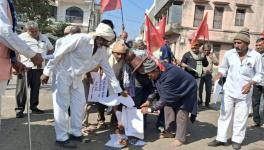Is This How You Are Doubling Farmers’ Income, Mr Modi?
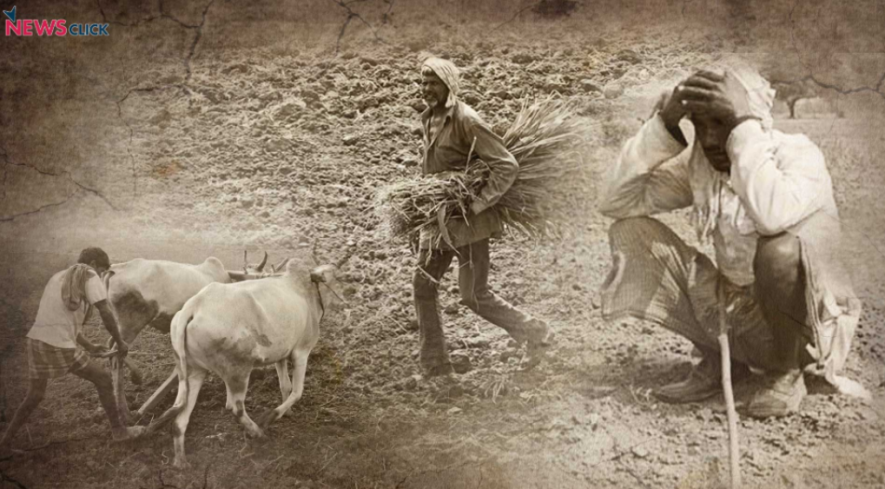
Addressing a farmers’ rally in Bareilly, Uttar Pradesh, in 2016, Prime Minister Modi had announced that he wanted to double farmers’ incomes by 2022. Before that, he had addressed several farmers’ rallies in other states, in an attempt to assuage the unrest roiling the farmers after two successive years of drought, a botched attempt to get a draconian land acquisition law passed, and a wave of farmers’ protests. So, this announcement was meant to be a brahmastra, a mantra that would reassure the farmers once and for all.
After that, the Modi machinery went into overdrive. A ‘Committee on Doubling Farmers Income’ was appointed to work out the details. NITI Aayog brought out a quick report by March 2017. The Committee finally completed its 14-volume report in September 2018, although it was said that work had already started on its interim recommendation. And the PM, too, refers to his vision intermittently in speeches.
So, how is it going, this doubling of incomes? Is it happening? What has been done, apart from giving a direct benefit transfer of Rs 6,000 per year to about nine crore farmers?
Neglected Class
Before going into all that, it is essential to bring on stage some 14 crore agricultural workers who are the backbone of the agrarian economy. Without them, nothing will work. Recently, did you notice the lament that arose when rabi harvesting suffered due to non-availability of labour under lockdown conditions? It may be argued that if farmers’ incomes are raised, wages of these landless labourers will also go up. But besides not being true, wouldn’t it be as important to increase their wages and working/living conditions too? After all, they are the poorest of poor, a large proportion being dalits or adivasis, with low literacy rates, abysmal incomes, and no hopes of moving beyond the shackles of dire poverty.
Also read: The Truth Behind Modi’s Agri Infra Investment
Strangely, agricultural workers are absent from any vision of the future that Modi has. Such is the indifference that monthly wage rates as collected by the Labour Bureau from across the country have not been put out since March this year. But even the available data (drawn from RBI’s database) shows a grim and forbidding picture: in the past three years, daily wages have risen by a mere Rs 33! [See chart below]
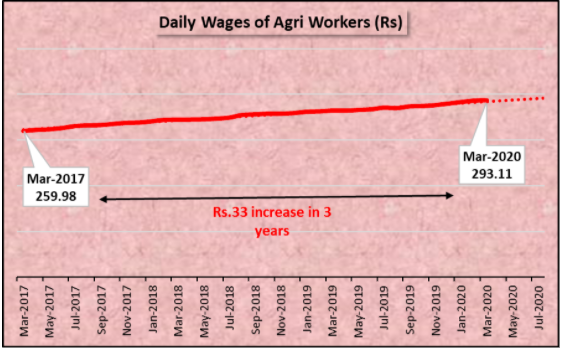
Remember that the landless labourer works only seasonally. Otherwise, they have to look elsewhere, do odd jobs, work in construction sites, and so on. So, the income earned at these measly rates has to be spread out over a 12-month period. Although this ugly reality of agricultural workers’ plight was not part of Modi’s dream, it needs to be kept in mind as we look at actual cultivators.
What Do Farmers Get For Their Harvest: Wheat
Let us look at the major rabi (winter) crop, wheat. In the last rabi season, some 107 million tonnes of wheat is estimated to have been produced by farmers, which is an all time record. It makes up about 39% of all cereal output of the country. In the chart below, you can see a comparison between the total cost of wheat production (C2), the declared Minimum Support Price (MSP) and the projected C2+50% which is a long standing demand of the farmers and a recommendation of the M.S.Swaminathan headed National Farmers’ Commission appointed in 2004. Data is taken from the Rabi Price Policy Reports of the Commission for Agricultural Costs & Prices (CACP).
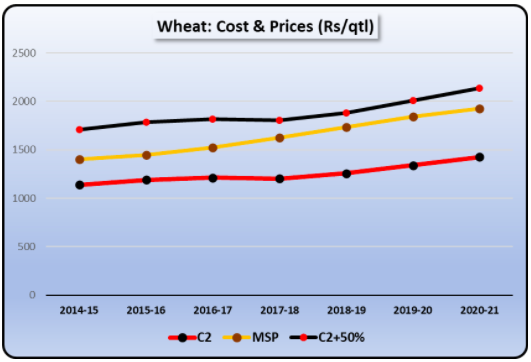
The Modi government has falsely been claiming that it is giving 50% more than the total cost of production. They are indulging in a sleight of hand by defining total cost in a different way, by excluding rent, etc. In reality, over the Modi years, MSP for wheat has remained below the C2+50% benchmark. For instance, in the 2020-21 rabi season, MSP for wheat is pegged at Rs 1,925 per quintal while the C2+50% cost is Rs 2,138 per quintal.
In short, for the major crop of wheat, MSP is still less than the actual total cost of production plus 50%. Remember, this one crop takes five months or so to be ready. So the farmer is barely meeting their costs and has very little left over, after five months of labour. The situation is worse for other rabi crops like barley, lentil, gram and rapeseed/mustard where procurement is much lower and prices, too, are much less than C2 costs.
What Do Farmers Get For Their Harvest: Rice/Paddy
A similar situation prevails for the biggest crop in India, rice. In the previous kharif (monsoon) crop season about 118 million tonnes of rice was produced in the country, again an all time record. The cost and price comparison (as put out in CACP’s Kharif Price Policy Reports) is given in the chart below:
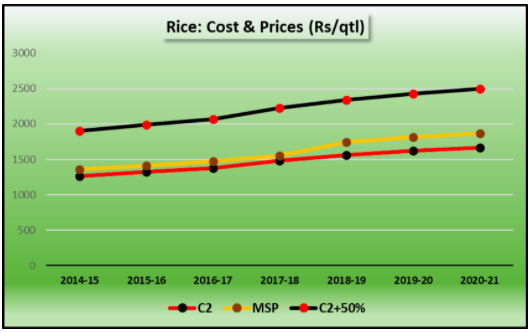
In this case, the situation is even more dire. The gap between C2+50% cost and declared MSP is far wider, indicating that the farmers are getting a very little margin of profit over their total cost of production. For example, in 2020-21 Kharif Marketing Season, MSP was Rs 1,868 per quintal while the C2+50% level would be Rs 2,501 per quintal. That’s a huge gap of nearly 34%. This is effectively a loss for the farmers.
The situation is similar, or even worse, in other kharif crops like jowar, bajra, arhar (tur), and oilseeds like groundnut and soybean.
So, quite the contrary to PM Modi’s claim that he and his efficient government is working tirelessly to double farmers’ incomes, the only significant way that farmers’ incomes would increase has not been adopted. In fact, a pretence is being made that total cost +50% is being given while it is not. So, its not just failure – it is failure and telling lies to hide the failure.
Further Destruction Is Coming
In addition to this gross neglect, the Modi government has recently passed ordinances that will further destroy the fragile economy of farming in India, by allowing big corporate entities (including foreign players) to intervene in a whole range of activities, from production (contract farming), to trade (APMC), stocks and pricing (ECA scrapping). These biggies have deep pockets and are going to arm twist the farmers, especially the vulnerable small and marginal ones, into growing and selling what the companies want, and then determining prices by stocking and manipulating prices. These so called reforms have been peddled as “freedom for farmers” whereas actually they are paths to bondage and economic ruin. This is what the real agenda of the Modi government was – all the talk of doubling farmers’ incomes was mere hogwash.
Time will tell what the hapless farmers will do about all this. Some indication came in a recent protest on August 9, when thousands of farmers and agricultural workers joined hands with industrial workers and employees to protest against these and similar policies.
Also watch: Can Big Companies Help Farmers?
Get the latest reports & analysis with people's perspective on Protests, movements & deep analytical videos, discussions of the current affairs in your Telegram app. Subscribe to NewsClick's Telegram channel & get Real-Time updates on stories, as they get published on our website.









